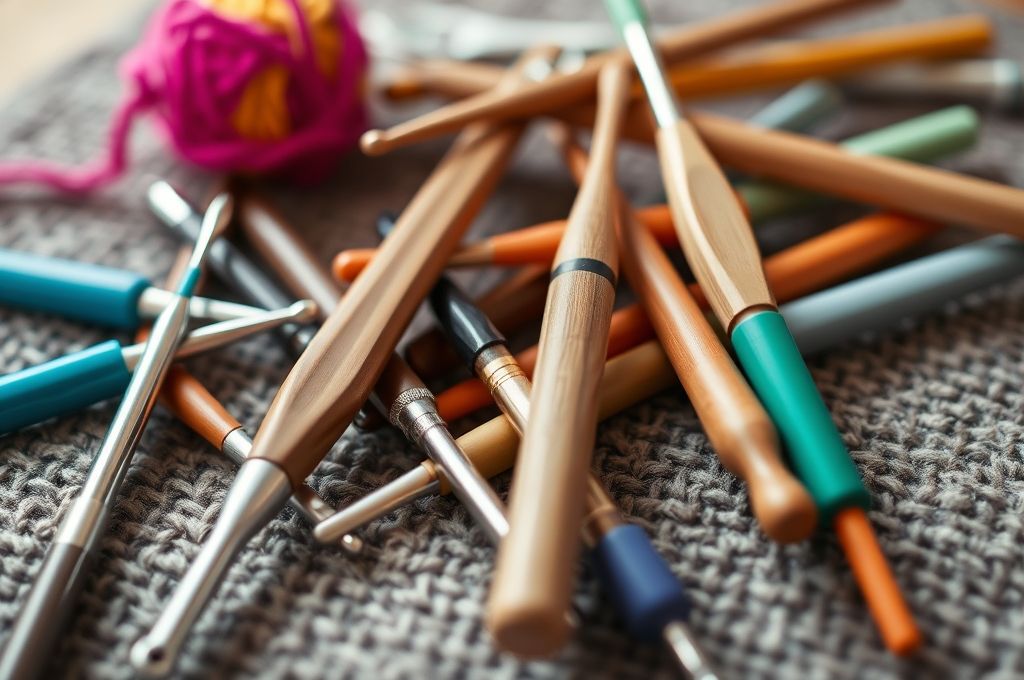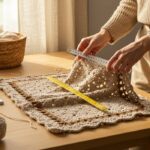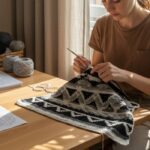The Little Tool That Makes a Big Difference
Have you ever finished a crochet project with stiff fingers, wrist pain, or a nagging ache in your hand—only to realize the culprit wasn’t your technique, but the tool in your grip? You’re not alone. For many crafters, the humble crochet hook is just another tool in the box. But the truth is, your choice of hook—its material, weight, shape, and ergonomics—can make the difference between a joyful crafting session and one that leaves you wincing for hours.
Crocheting is more than a hobby; it’s a form of self-expression, relaxation, and even therapy. Whether you’re whipping up a cozy blanket, designing a delicate shawl, or crafting adorable amigurumi, the experience should feel satisfying—not painful. Yet, so many crafters overlook one of the most critical elements of their craft: the hook itself.
In this guide, we’ll dive deep into the world of crochet hooks, exploring the different materials available—from classic aluminum to ergonomic silicone—and how each impacts your comfort, control, and creativity. We’ll also examine the importance of ergonomics, especially for those who crochet for long stretches or live with arthritis, carpal tunnel, or hand fatigue. By the end, you’ll not only understand why your hook matters, but you’ll also know exactly how to choose the one that works best for you.
Let’s unravel the secrets behind the perfect hook—because when your tool feels good, your stitches flow better, your projects turn out smoother, and your love for crocheting grows stronger.
Why the Material of Your Crochet Hook Matters
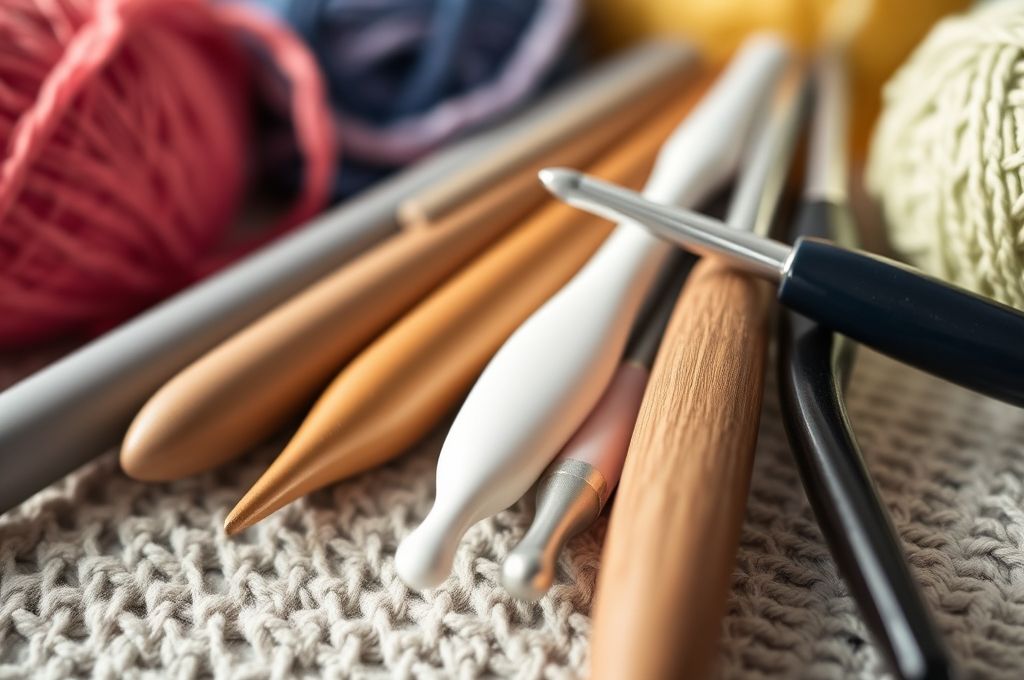
When you pick up a crochet hook, you might not think much about what it’s made of. After all, as long as it pulls yarn through loops, it does the job, right? Not exactly.
The material of your hook influences everything: how smoothly your yarn glides, how much friction you feel, how warm or cold the hook feels in your hand, and even how long you can comfortably use it. Think of it like choosing between a wooden spoon and a silicone spatula for cooking—one might be better for stirring, the other for scraping. The same logic applies here.
Let’s break down the most common materials used in crochet hooks:
- Aluminum: Lightweight, smooth, and affordable, aluminum hooks are a favorite among beginners and experienced crocheters alike. They allow yarn to slide effortlessly, making them ideal for fast-paced projects. However, their slick surface can sometimes cause stitches to slip too easily, especially with slippery yarns like silk or rayon.
- Plastic: Often found in budget-friendly sets, plastic hooks are lightweight and come in fun colors. But they can feel flimsy and may wear down over time, especially with frequent use.
- Wood: Warm to the touch and naturally grippy, wooden hooks offer excellent control and a satisfying tactile feel. They’re perfect for those who like a bit of resistance and prefer a quieter crocheting experience (no clinking!). However, they may not be as smooth with certain yarns and can require more effort to pull through tight stitches.
- Bamboo: A subset of wood, bamboo is lightweight, sustainable, and slightly more flexible than hardwood. It’s great for beginners and those with sensitive hands, offering a balance between grip and glide.
- Steel: Used primarily for fine thread crochet (like doilies or lace), steel hooks are precise and durable. They’re essential for intricate work but can feel cold and unforgiving during long sessions.
Choosing the right material isn’t just about preference—it’s about matching your tool to your project, your yarn, and your body’s needs. And as we’ll see next, comfort goes far beyond just the material.
Ergonomics: Designing for Comfort and Longevity
Imagine typing on a keyboard with keys that don’t respond, or walking in shoes that pinch your toes. Eventually, discomfort turns into pain. The same principle applies to crocheting. If your hook doesn’t fit your hand well, every stitch adds strain.
This is where ergonomics comes in—the science of designing tools to fit the human body. An ergonomic crochet hook is designed to reduce pressure on your hand, wrist, and forearm, allowing you to crochet longer with less fatigue.
Standard hooks, especially the classic tapered aluminum kind, often force your hand into a cramped, claw-like grip. Over time, this can lead to repetitive strain injuries, especially if you’re working on large projects like afghans or sweaters.
Enter ergonomic hooks—designed with cushioned, contoured, or extended handles that distribute pressure more evenly across your palm. These hooks encourage a more natural hand position, reducing the need to pinch or squeeze.
Popular ergonomic designs include:
- Soft-grip handles: Made from rubber or silicone, these provide cushioning and improve grip, especially helpful for those with arthritis or weak hand strength.
- Extended handles: These shift the balance of the hook, reducing finger strain by allowing your palm to support more of the tool’s weight.
- Anatomical shaping: Some brands design handles that mimic the natural curve of your hand, promoting a relaxed grip.
A study published in the Journal of Hand Therapy found that ergonomic tools significantly reduced discomfort in users with hand conditions. For crocheters, this means less pain, fewer breaks, and more time creating.
But ergonomics isn’t just for those with existing pain. It’s about prevention—protecting your hands so you can enjoy your craft for years to come.
Material vs. Ergonomics: Finding the Right Balance
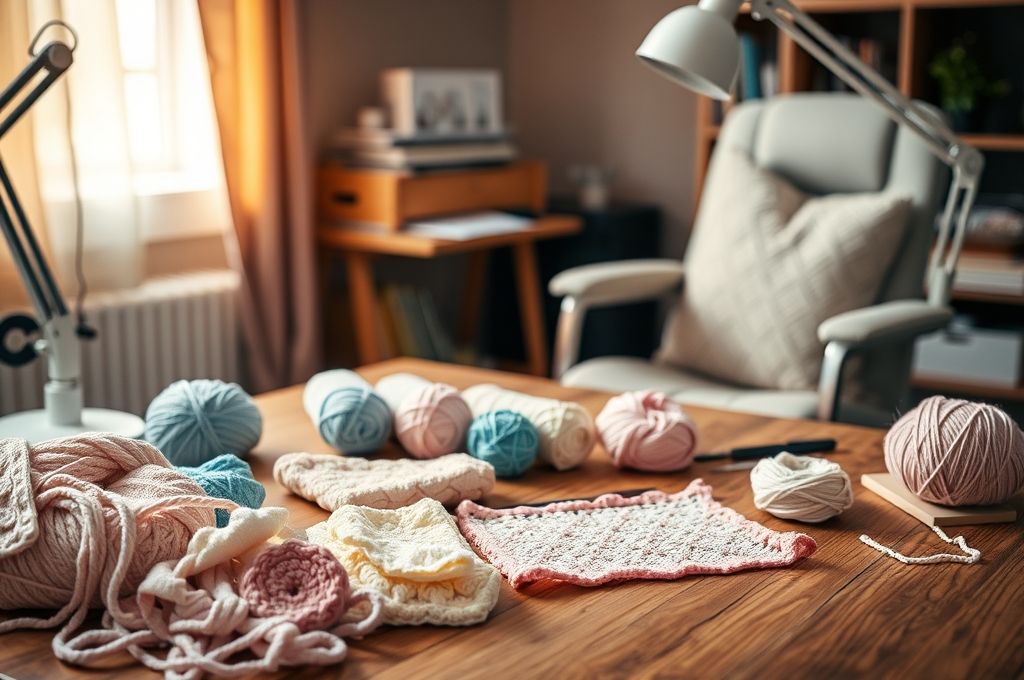
Now that we’ve explored materials and ergonomics separately, let’s put them together. The ideal crochet hook isn’t just about one factor—it’s about the combination of material and design that suits your needs.
For example:
- A bamboo ergonomic hook offers warmth, grip, and comfort—perfect for slow, mindful projects like lace or baby clothes.
- An aluminum hook with a soft-grip handle gives you the smoothness of metal with the cushioning of rubber—great for fast, repetitive stitching.
- A steel ergonomic hook might be rare, but for fine thread work, even a small cushioned grip can make a big difference in hand fatigue.
Let’s consider real-life scenarios:
Sarah, a retired teacher, loves crocheting prayer shawls for her church. She used to use basic aluminum hooks but started experiencing wrist pain after an hour. Switching to a bamboo ergonomic hook reduced her discomfort and doubled her stitching time.
Jamal, a college student, makes amigurumi toys to sell online. He needs speed and precision. He found that lightweight aluminum hooks with a silicone grip gave him the control and comfort he needed for long nights of tight stitching.
The key is experimentation. Just like not every shoe fits every foot, not every hook fits every hand. Your ideal hook depends on:
- The type of projects you make
- The yarns you use
- Your hand size and strength
- Any existing hand or wrist conditions
So don’t be afraid to try different combinations. Many craft stores sell individual hooks or starter sets, so you can test before committing to a full set.
Common Hand and Wrist Issues Among Crocheters (And How the Right Hook Can Help)
Crocheting is a repetitive motion. Your fingers, thumb, and wrist move in the same pattern over and over—sometimes for hours. While this rhythm can be meditative, it can also lead to strain if not managed properly.
Common issues include:
- Carpal tunnel syndrome: Caused by pressure on the median nerve in the wrist, often resulting in numbness, tingling, or weakness.
- Tendonitis: Inflammation of the tendons in the hand or forearm, usually from overuse.
- Arthritis: Both osteoarthritis and rheumatoid arthritis can make gripping tools painful.
- Trigger finger: A condition where a finger gets stuck in a bent position due to inflamed tendons.
These aren’t just problems for older adults. Younger crocheters who binge on big projects during weekends or craft fairs can also develop strain.
The good news? The right hook can help prevent or alleviate these issues.
For example:
- Ergonomic hooks reduce the need for tight gripping, lowering pressure on tendons and nerves.
- Lighter materials like bamboo or plastic reduce overall hand fatigue.
- Warmer materials like wood feel more comfortable in cold hands, improving circulation.
A 2020 survey by the Craft Yarn Council found that 68% of crocheters reported hand or wrist discomfort after two hours of continuous work. But among those using ergonomic tools, that number dropped to just 32%.
Simple changes can make a big difference:
- Take breaks every 20–30 minutes.
- Stretch your hands and wrists.
- Use a thimble or finger guard to reduce friction.
- Most importantly, switch to a hook that supports your body, not fights against it.
Your hands are your most valuable tools—treat them with care.
Top Crochet Hook Brands That Prioritize Ergonomics and Quality
Not all crochet hooks are created equal. Some brands have made it their mission to combine quality materials with thoughtful ergonomic design. Here are a few standouts:
- Clover Amour: These hooks feature a smooth, polished aluminum shaft with a soft, contoured PVC handle. The ergonomic shape fits naturally in the palm, reducing finger strain. Available in a wide range of sizes, they’re a favorite among both beginners and pros.
- Susan Bates Silvalume: Known for their lightweight aluminum construction and satin finish, these hooks offer smooth stitching with a comfortable grip. While not fully ergonomic, their balanced weight makes them easy on the hands.
- Boye Ergo Comfort: Designed specifically for comfort, these hooks have a cushioned, non-slip grip and a wider handle that reduces pressure on the fingers. Ideal for those with arthritis or hand pain.
- Knitter’s Pride Karbonz: Made from lightweight carbon fiber with a smooth wood-like finish, these hooks are strong, warm to the touch, and gentle on the hands. The sleek design also prevents yarn snagging.
- Furls Odyssey: A premium option, Furls hooks are handcrafted from resin or hardwood with ergonomic shaping. They’re heavier but beautifully balanced, offering a luxurious feel and excellent control.
- Pony Soft Feel: An affordable ergonomic option, these hooks have a soft rubber grip and a classic aluminum shaft. Great for beginners exploring comfort-focused tools.
When choosing a brand, consider:
- Price vs. value: A $20 ergonomic hook might seem expensive, but if it lets you crochet pain-free for years, it’s an investment in your health.
- Availability: Some brands are easier to find locally, while others require online ordering.
- Return policies: If you’re buying online, check if you can return or exchange if the hook doesn’t feel right.
Remember: the most expensive hook isn’t always the best. The best hook is the one that feels right in your hand.
How to Test a Crochet Hook Before Buying
You wouldn’t buy shoes without trying them on, right? The same should go for crochet hooks. But since many are purchased online, how can you test them?
Here are some practical tips:
- Check the weight: A heavier hook can cause fatigue over time, while a very light one might feel flimsy. Hold it in your hand—does it feel balanced?
- Test the grip: Run your fingers over the handle. Is it smooth, grippy, or cushioned? Does it fit comfortably in your palm, or does it dig in?
- Try the shaft: Look at the transition between the handle and the shaft. Is it smooth, or does it create a pressure point? A seamless design is best.
- Swing test: Hold the hook like a pencil and gently swing it. Does it feel stable, or does it wobble? A well-balanced hook reduces wrist strain.
- Yarn glide test: If possible, try crocheting a few stitches. Does the yarn slide smoothly, or does it catch? Does the hook feel too thick or too thin for your yarn?
Many craft stores let you handle hooks in person. If you’re shopping online, look for brands that offer sample packs or money-back guarantees.
You can also ask fellow crocheters in Facebook groups, Reddit threads, or Ravelry for personal recommendations. Real user experiences can be more helpful than any product description.
And don’t forget: your needs may change over time. A hook that worked perfectly five years ago might not suit you today—especially if you’ve developed hand issues or switched to different types of projects.
DIY Ergonomic Upgrades: Making Your Current Hooks More Comfortable
Not ready to invest in a new set? No problem. You can improve the comfort of your existing hooks with simple DIY hacks.
Here are a few easy, low-cost solutions:
- Foam tubing: Cut a small piece of craft foam or sponge and slide it over the handle. Secure it with a drop of glue if needed. Instant cushion!
- Rubber grip tape: Used in sports equipment, this self-adhesive tape adds texture and padding. Wrap it around the shaft for better control.
- Yarn or floss wrapping: Tightly wrap embroidery floss or thin yarn around the handle. Not only does it add grip, but you can choose fun colors to personalize your hook.
- Heat-moldable grips: Products like Sugru or Pro-Tekt are moldable silicone that hardens into a custom-fit grip. Shape it to your hand, let it set, and you’ve got a personalized ergonomic handle.
- Pen grips: Those rubber grips used for writing pens? They fit perfectly on many standard hooks and add instant comfort.
These upgrades are especially great for:
- Treasured vintage hooks you don’t want to replace
- Borrowed or inherited tools
- Testing ergonomic features before buying new ones
One crocheter even shared how she used a wine cork—cut and shaped—to create a custom wooden handle for her favorite steel hook. Creativity knows no bounds!
The point is: you don’t need to spend a lot to make your crocheting more comfortable. A little ingenuity goes a long way.
Choosing the Right Hook for Different Projects and Yarns
Just as a chef uses different knives for different tasks, a skilled crocheter chooses the right hook for the job.
Here’s a quick guide:
| Fine lace or thread | Steel or aluminum | Precision and smoothness are key for tight, delicate stitches. |
| Baby blankets or garments | Bamboo or wood | Warm, soft, and gentle on sensitive yarns like cotton or merino. |
| Amigurumi (stuffed toys) | Aluminum or ergonomic plastic | Smooth stitching for tight, even rounds; lightweight for long sessions. |
| Afghans or large throws | Ergonomic aluminum or carbon fiber | Reduces hand fatigue during hours of repetitive stitching. |
| Bulky yarn projects | Wood or bamboo | Heavier hooks help manage thick yarn; natural grip prevents slipping. |
Yarn texture also matters:
- Smooth yarns (acrylic, silk): Pair well with slick hooks like aluminum.
- Sticky yarns (cotton, wool): Work better with grippier materials like wood or bamboo.
- Fuzzy or textured yarns: May snag on rough hooks—opt for polished metal or resin.
And don’t forget hook size. Always check your pattern’s recommendation, but also consider how the hook feels. A slightly larger hook can reduce tension and strain, even if it changes your gauge slightly.
Ultimately, the “right” hook is the one that makes your project enjoyable—not just functional.
The Emotional Side of Tools: Why Comfort Enhances Creativity
Here’s something we don’t talk about enough: how your tools affect your mood.
When your hands hurt, your mind tenses. You focus more on the discomfort than the joy of creating. But when your hook feels good—when it glides smoothly, fits perfectly, and doesn’t fight you—something shifts.
You relax. You breathe deeper. You lose yourself in the rhythm of the stitches.
Comfort isn’t just physical—it’s emotional. And when you feel good, you create better.
Think of your crochet hook as a partner in your creative journey. It’s not just a tool; it’s an extension of your hands, your ideas, your heart.
Choosing a hook that supports you—literally and figuratively—can reignite your passion for crocheting. It can turn a chore into a ritual, a hobby into a sanctuary.
One crocheter shared how switching to an ergonomic hook helped her return to crafting after years of pain-related burnout. “It wasn’t just my hands that healed,” she said. “It was my love for making.”
That’s the power of the right tool.
Conclusion: Crochet Smarter, Not Harder
We’ve covered a lot—from the science of materials to the art of ergonomics, from brand comparisons to DIY hacks. But the core message is simple: your crochet hook matters more than you think.
It’s not just about completing a project. It’s about how you feel while doing it. It’s about protecting your hands, enjoying the process, and staying creative for years to come.
Whether you’re a beginner just learning the chain stitch or a seasoned pro working on your 50th blanket, take a moment to evaluate your tools. Ask yourself:
- Does my hook feel comfortable after 30 minutes?
- Am I gripping too tightly?
- Could a different material or design make this easier?
Then, take action. Try a new hook. Wrap your old one. Invest in ergonomics. Your hands will thank you.
Crocheting is a gift—a way to create beauty, express yourself, and connect with others. Don’t let discomfort steal that joy.
So go ahead: hook yourself up with the right tool. Your next project—and your future self—will be glad you did.
And hey, we’d love to hear from you! What’s your favorite crochet hook? Have you tried ergonomic ones? Share your story in the comments below—let’s build a community of happy, pain-free crocheters together.
Happy hooking! 🪝❤️

Daniele Ferreira is passionate about the world of crochet, dedicating her time to exploring techniques, creating unique pieces, and sharing her knowledge with beginners and aficionados alike. With attention to detail and creativity, she transforms yarn into true works of art, inspiring others to discover the beauty and joy of this manual art.

